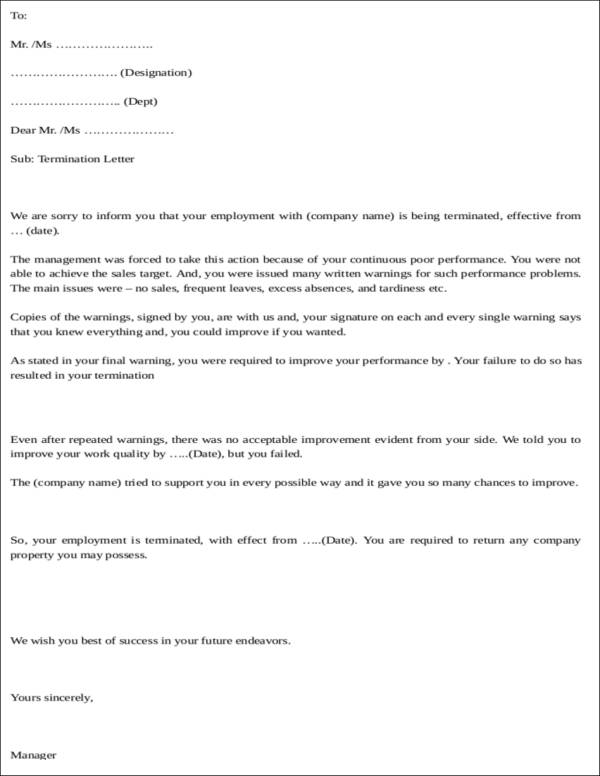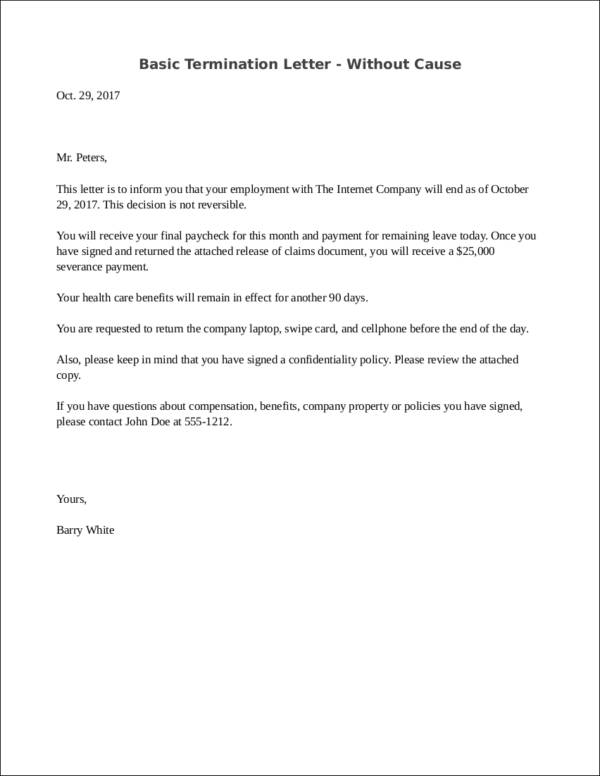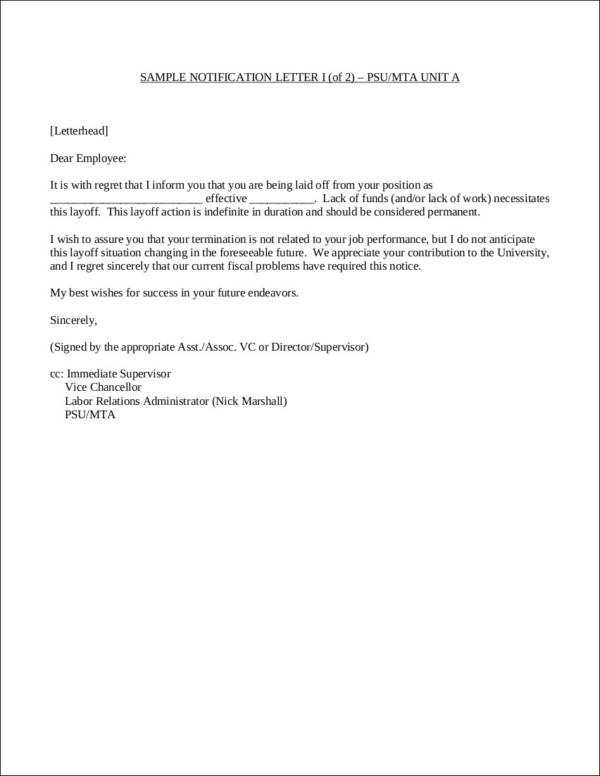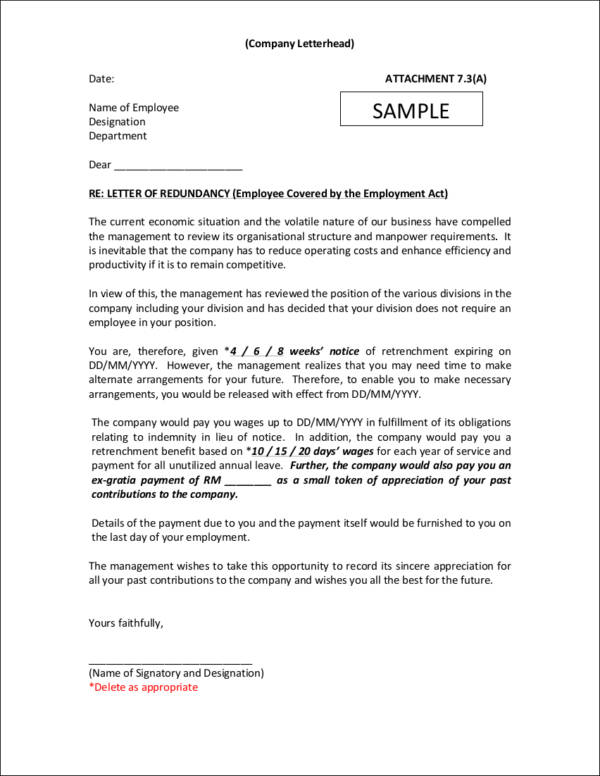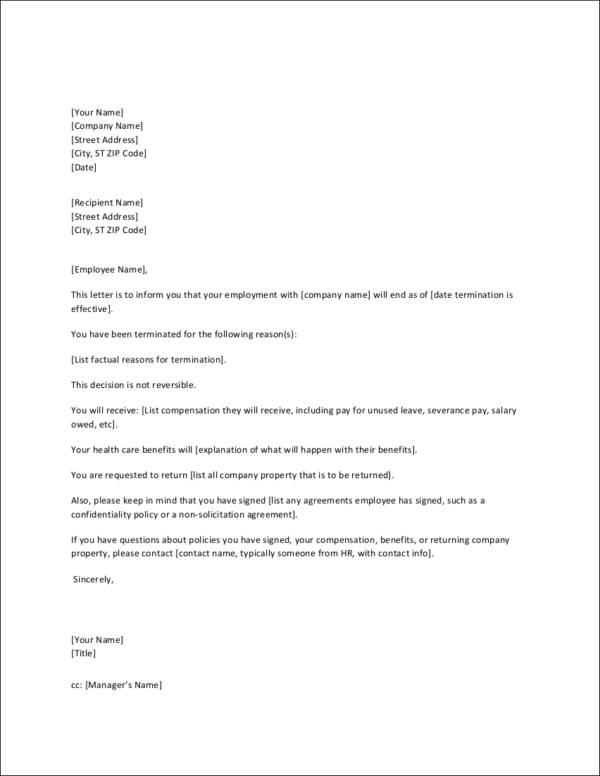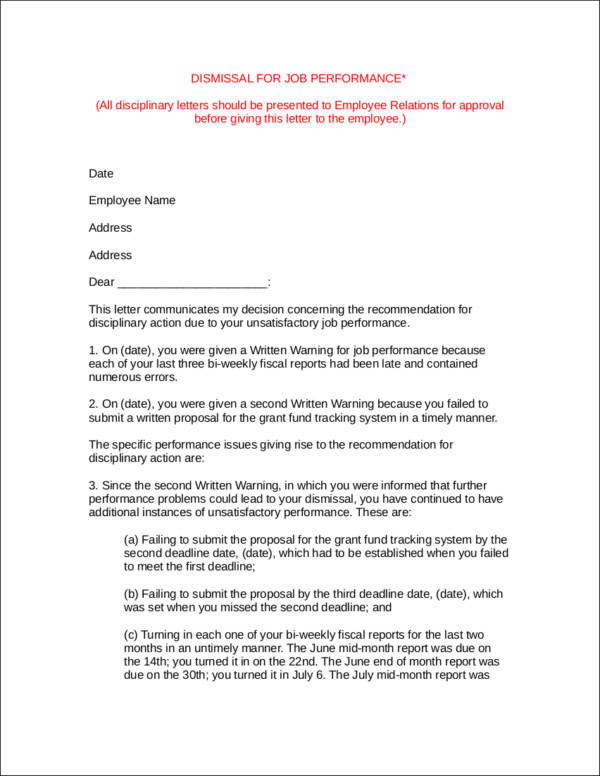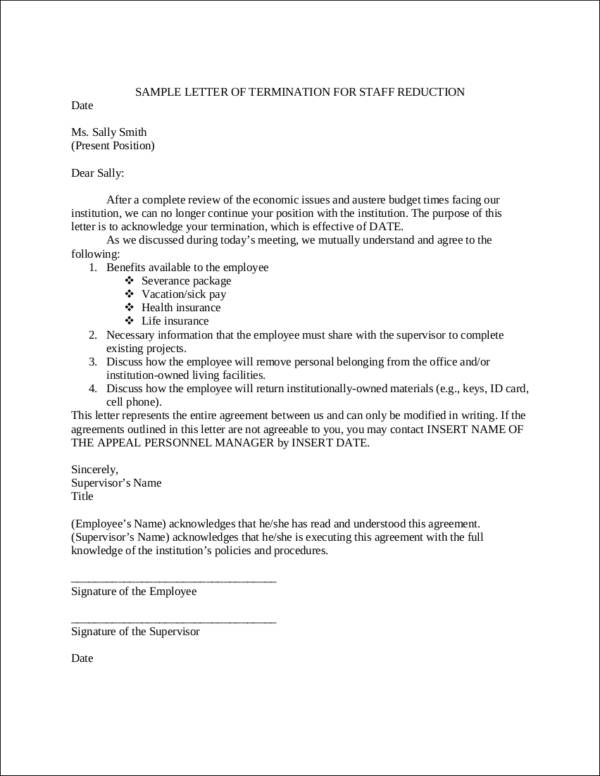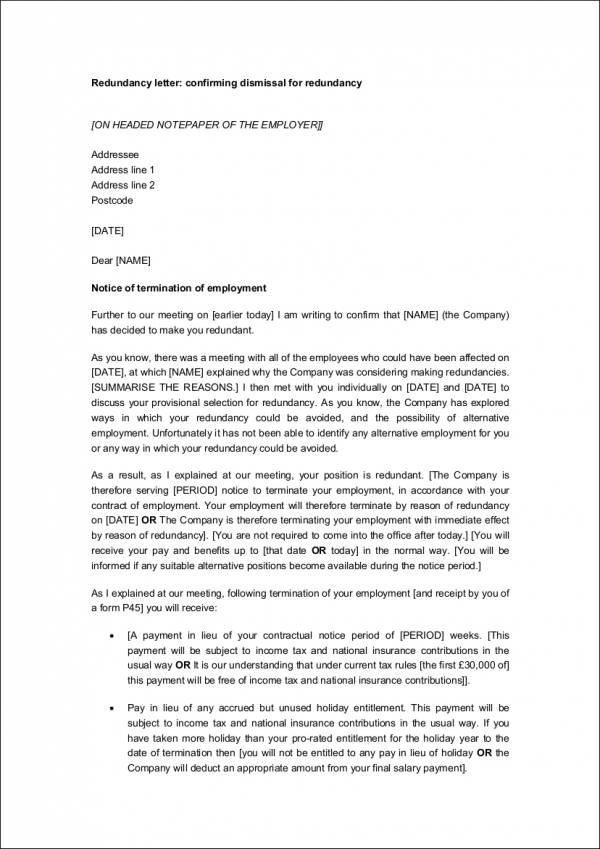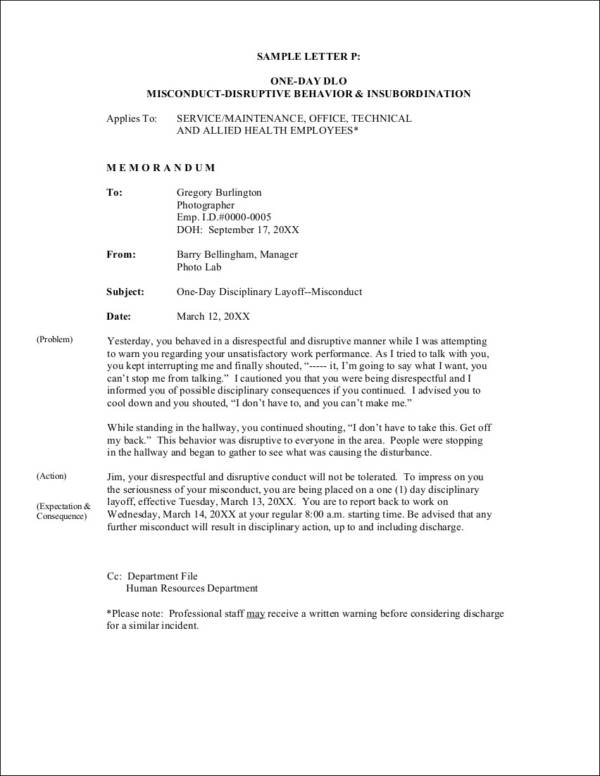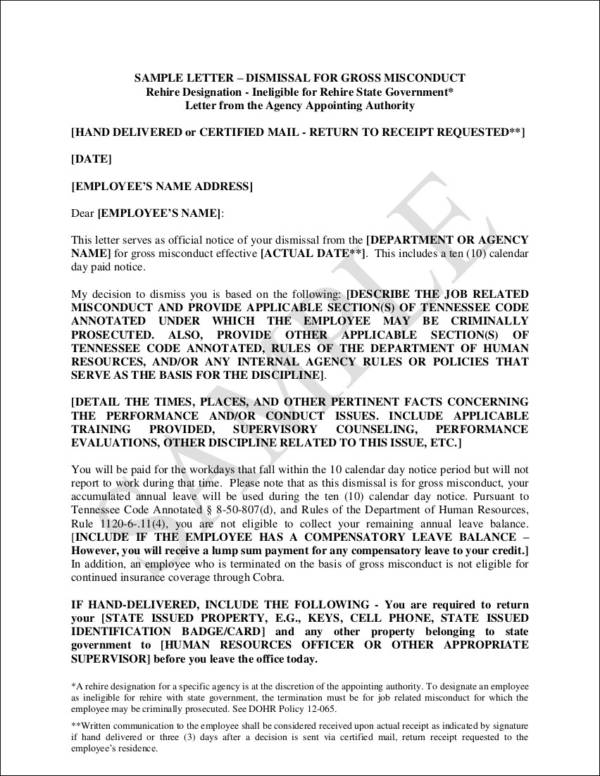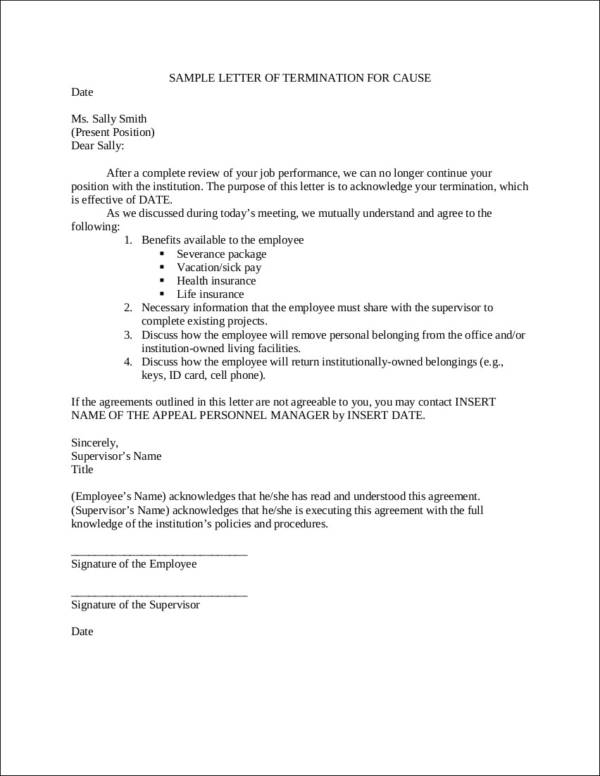Companies hire new employees every day, especially if the kind of business that a company runs is one that is growing and is consistently in demand for more employees. On the other hand, it is also a fact that no matter how much companies hire new employees and no matter how much they try to keep those employees, there will always be instances when they need to issue company termination letters and let go of them.
Company termination letters are as important as all the other employment documents in existence. Here we have prepared company termination letter samples and templates in different file formats that you can view and download for your personal use. Useful topics have also been included to help us further understand company termination letters. You may also see sample termination of business letters.
Sample Company Termination Letter for Poor Performance
Basic Company Termination Letter without Cause
Early Termination Letter Sample for Loss of Funding
Company Termination Letter Due to Lack of Funds and/or Work
Sample Employee Termination Letter
Company Termination Letter Template
Sample Company Letter of Dismissal
When Does a Company Issue a Termination Letter?
A company termination letter can only be issued by a company or an employer to any terminable employee. Of course, terminating an employee without reason or just cause is against the law. That is why this simple termination letter is only issued when a company or employer thinks that the employee needs to go. There are a number reasons of why a company termination letter is issued. We have made a list of some of the common reasons why and they are listed below.
- The employee is no longer fit to work or able to work and has health problems that hinder them from doing their job.
- The company is cutting costs or is experiencing financial business problems.
- The employee has not met the standards or has failed to pass the metrics required by the company for every employee.
- The employee has adherence issues and attendance issues that pull down the company’s productivity.
- The company no longer needs the services of the employee or entity.
- The employee has incurred violations that are the basis or grounds for the termination of their employment.
- The employee has committed certain crimes that may drag down the company’s reputation.
- The company and employee agreement is contractual and therefore needs to be terminated at the specified date.
- The employee has violated the company’s code of conduct and has breached the employment contract.
- The employee is incompetent and has incurred insubordination issues.
- The employee has shown violence against another employee.
The reasons for termination vary depending on the situation and most especially depending on how the company handles the said situation. There could be more reasons for terminating an employee than what has been listed above. If you should fire an employee due to any of the reasons above, then you might find some of the articles we offer on our website. They are sample termination letter for the workplace and writing termination letters due to poor performance.
Sample Letter of Termination for Staff Reduction
Termination Letter Confirming Dismissal for Redundancy
Company Termination Letter for Insubordination
Company Termination Letter for Gross Misconduct
Company Termination Letter for Current Position
Parts of a Company Termination Letter
A termination has certain parts that are similar to that of other letters, whether they be application letters, thank-you letters, or business letters. Let’s name and describe each part below.
1. Header or Letterhead
A header or letterhead is always written on the top center part of any document, even if it is not a letter. The letterheaded paper makes it look more professional and reliable, aside from being used to make it easy to identify what the paper is for. It contains the name and address, and contact details of the company who will be sending the letter. You may also see sample contract termination letters.
2. Date
You can find the date at the upper left-hand side of the formal letter usually a couple of spaces below the letterhead. The proper way to write the date in a letter should be like this: April 16, 2018. The name of the month should not be abbreviated and the full 4 digits of the year should be present. The date written should be the date when the letter is sent and not the date when it was made.
3. Address Block
The details of the recipient of the letter is what the address block contains. It is usually composed of 3 to 4 lines. The first and second line should include the name and designation of the recipient. The third line should include the department where the employee or recipient belongs in the company, and the fourth line is where the address and contact details are written. See example below:
John Smith
Customer Service Representative
Email Support Department
Conquest Wireless Inc., New York, NY 10001
4. Salutation
The commonly used salutation in a letter, regardless of whether it is a formal letter or an informal letter, starts with the word Dear and then followed by the last name of the recipient. Examples is “Dear Mr. Smith.” Other salutations may be used in other types of letters, but the one mentioned above may seem appropriate when writing termination letters.
5. Body of the Letter
The body of the letter is the main part of the letter because this is where you can find the reason why the letter is written, or the reason for the termination. It is made up of three paragraphs. The first paragraph is where you will find the reason why the recipient is receiving the letter and the date when the termination is going to be effective. In the second letter, a detailed encounter of what made the company decide to terminate the employee. And the last paragraph is a summary of what has been written. It often includes a statement about who the employee should contact if he/she has any questions about the termination.
6. Complimentary Close
The complimentary close is the indication that the letter is about to end. “Sincerely yours,” and “Respectfully yours,” are appropriate words to use when closing your letter. Aside from the given samples, any complimentary close can be used in other types of letters. The preferred complimentary closes for formal letters need to convey respect to the recipient of the letter, such as the samples provided above. In personal letters, complimentary closes like “Best wishes,” Hugs and kisses” are acceptable, especially if the sender is writing to a close friend or family.
7. Signature Block
A couple of spaces below the complimentary close is where you can find the signature block. It contains the full name of the person who wrote the letter, their designation, their signature, and the date when the letter was signed. There is also a space provided for the recipient to write their name and affix their signature. This serves as acknowledgment that they have received the letter and was properly notified about the termination. You may also like client termination letters.
Company termination letters are formal letters. Therefore, they should be written using a formal letter format. Other examples of formal letters are official resignation letters, recommendation letters, and company introduction letters. You can also find samples and templates of different types of on our website.
Why is it Important to Issue Termination Letters?
Hiring an employee requires that a company follows the company standard procedures before completely declaring that the applicant is hired. There are laws and regulations that govern these things so that due process is followed by all companies, private or public. The same thing is true for terminating employees. Due process should also be followed in order to make the termination legal and according to the company’s termination terms and conditions. This means that an employee should be terminated for reason and never without reason as long as that is provided in their employment contract. Failing to do so will put the company in a bad position and will incur legal liabilities aside from the breach of contract. You may also check out sample job termination letters.
Employees should also receive warning or notification of the violation or offense they have made before they get terminated. This is if the offense is not something that awards immediate termination. It is easy to remember these things if you are well aware of the law. Articles related to different termination letters will greatly help you learn more about them. Some article we have available on our website are Tenancy Termination Letters, Sample Contract Termination Letters, and Sample Lease Termination Letters.
Related Posts
Resignation Letter for Medical Samples & Templates
Letter of Intent Samples & Templates
Letter of Intent for a Job Samples & Templates
Lease Proposal Letter Samples & Templates
Letter of Inquiry Samples & Templates
Character Reference Letter Samples & Templates
Claims Letter Samples & Templates
Response Letter Sample & Templates
Follow Up Letter Samples & Templates
Sample Project Proposal Letter Templates
Donation Letter Samples & Templates
Addressing a Formal Letter Samples & Templates
Grievance Letter Samples & Templates
Sample Sponsor Thank You Letter Templates
Sample Letters of Request

